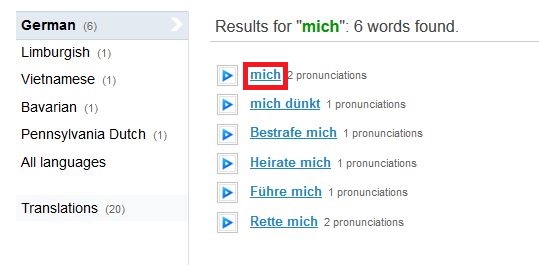When you’re studying a foreign language, do you learn a lot of new words by reading?
I do. Even though I’m a big proponent of a listening-based approach, I often rely on written texts and word lists to build my vocabulary.
But there’s a problem with that. Two actually. First, I don’t know precisely how the new words sound, so I can’t easily recognize them while listening. Second, I also can’t pronounce them properly.
Luckily, there’s a free tool out there to help get around this: Forvo.
Why Pronunciation is Tricky
The letters of an alphabet are supposed to represent the sounds of a language. Unfortunately, in terms of phonology, writing systems are imprecise. (I mean, seriously, what’s the deal with the silent K?)
As native speakers of a language, we don’t find this too big of a deal. We learn our first language first by hearing it as children. Then when we learn to read, we match up written text with what we already know of the language that we’ve heard thousands of hours of.
Since alphabets are neither consistent within the same language nor among different ones, linguists (language scientists) have come up with an International Phonetic Alphabet. This alphabet is an amazing innovation and I’m absolutely impressed that professional linguists know and use this.
I’m going to be honest, though: I’m never going to use the IPA. You can chalk some of that up to laziness, I suppose. But authentic foreign language texts aren’t often written in IPA. And even if they were, I just don’t have it in me to spend my time dissecting a language with a scalpel and a magnifying glass.
So what then?
In Comes Forvo
Forvo is a website with pronunciations of millions of words, spanning over 300 languages. Users–typically native speakers of a language–upload a recording of them saying the word aloud. These words are then searchable by you, the language learner.
Here’s the procedure for how I learn to pronounce a new word:
1. Search for the word: Go to Forvo.com. Type the word in the search bar (red box, next graphic). Click the Go button. A list of results displays.
2. Select a search result: Click a result in the list. In this example, I want to see all the pronunciations for the word “mich,” so I click the top link (red box, next graphic).

3. Play the pronunciation: Click one of the play buttons (red boxes, next graphic). Notice that a brief description of the speakers is provided, so you can tell what country they’re from and what gender they are.
4. Listen: Play the pronunciation several times. If you want, close your eyes. Really pay attention to how the word feels in your ears. Notice things like the sounds of the consonants, the sounds of the vowels, the number of syllables, the rhythm of the syllables, and–if applicable–any rising or falling tones.
5. Repeat: Repeat after the speaker. Try to parrot the speaker as much as possible. Do your best to forget what’s written and instead focus on imitating the actual sound and matching the cadence. Repeat this as many times as necessary. I try to repeat after the speaker at least five times.
Pros and cons of this approach
If you do this, you’ll get several benefits:
- You’re repeating after a native speaker of the language so you’re emulating an authentic pronunciation.
- While you don’t get feedback, if you pay attention you’ll likely be able to hear how closely your own pronunciation matches the speaker’s.
- Hearing the word will help you remember it better, since you now have aural context to give the word additional “meaning.”
Admittedly, this method isn’t perfect:
- You’re not hearing how a word sounds like jumbled up with other words, as it would be in natural speech.
- The words are usually spoken a little slowly, so it’s a manufactured speaking pace.
- You may not get natural, colloquial pronunciations of words, so you might develop some stiff pronunciation patterns. For example, if you were learning English, you might develop the habit of saying “going to” instead of the more common “gonna” or “goin’ to.”
- It’s not practical to do this with every single new word you learn.
To that last point, what I suggest doing is not using Forvo to learn to pronounce every word, but just a sample of words. If you learned 20 words, for instance, then maybe try and run 5 of them through Forvo. Over time, this will add up and you’ll likely start picking up pronunciation patterns subconsciously.
Ultimately, I think the pros definitely outweigh the cons. At the very least, I recommend using Forvo to supplement other things you’re doing and adjusting this procedure for your own needs.
After all, if you begin matching the deliberate enunciation of Forvo clips and the biggest ding on your pronunciation is that you speak “too clearly,” then you’re not doing too bad.

